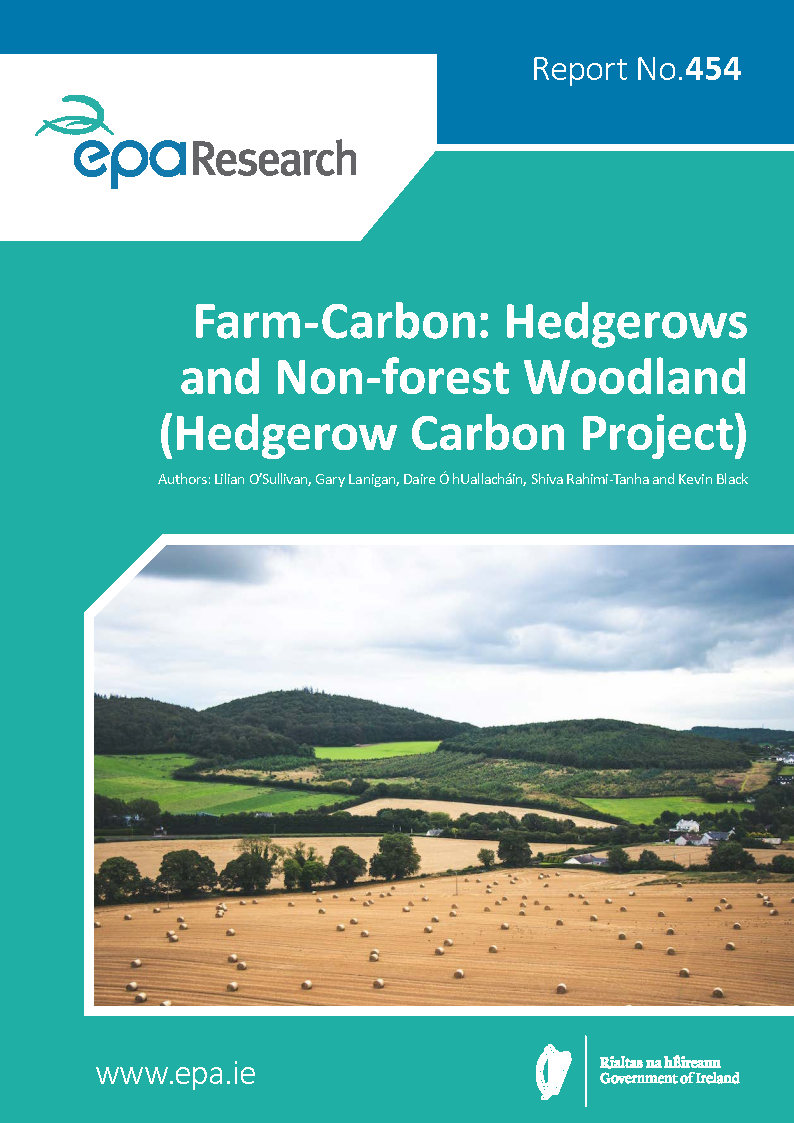Research 454: Farm-Carbon: Hedgerows and Non-forest Woodland (Hedgerow Carbon Project)
Authors: Lilian O’Sullivan, Gary Lanigan, Daire Ó hUallacháin, Shiva Rahimi-Tanha and Kevin Black
Summary: The EU aims to be climate neutral by 2050. Central to this ambition is land management that supports carbon sequestration, and enhancement of carbon sinks or the reversal of their emissions. Current national greenhouse gas emission inventory submissions to the United Nations Framework Convention on Climate Change show that the land use, land use change and forestry (LULUCF) sector is a net source of emissions in Ireland. However, emissions and removals are not currently disaggregated in national emission inventory estimates. Currently, hedgerows are not explicitly accounted for in national inventory reports.

Project highlights video
Identifying pressures
The EU aims to be climate neutral by 2050. Central to this ambition is land management that supports carbon sequestration, and enhancement of carbon sinks or the reversal of their emissions. Current national greenhouse gas emission inventory submissions to the United Nations Framework Convention on Climate Change show that the land use, land use change and forestry (LULUCF) sector is a net source of emissions in Ireland. However, emissions and removals are not currently disaggregated in national emission inventory estimates.
In previous research, hedgerows have been recognised as playing an important role in sequestering carbon, storing it in woody growth, roots, leaf litter and soil organic matter beneath the ground. In Ireland, hedgerows are an important perennial landscape feature, estimated to cover 689,000 km. To enable the estimation of the emissions and removal potential of hedgerows, assessments of carbon stock changes over time are needed. This would facilitate the inclusion of reporting of hedgerow removals and emissions in inventory submissions. However, accurate estimations of biomass have traditionally been difficult to establish. The aim of this research is therefore to advance understanding of the contribution of hedgerows and non-forest woodland (NFW) patches to carbon stocks in agricultural landscapes.
Informing policy
Ireland has committed to a series of international climate commitments that aim to address the impact of anthropogenic activities on the climate system. Collectively, these commitments endorse the important role of land-based activities in the mitigation of climate change. Delivering on climate ambitions envisages land use and management targeted towards the enhancement of carbon sinks, including the reversal of decreasing sinks.
Across the EU as a whole, the LULUCF sector represents a carbon sink, removing more carbon than it has emitted every year since 1990. In contrast, the Irish LULUCF sector has been a source of emissions every year from 1990 to 2020. Meeting emission reduction targets in this sector is set to become even more challenging, as the size of the national forest sink is reducing as a result of increased harvesting and reduced replanting.
In Ireland, hedgerows have been identified as an area with the potential to enhance terrestrial carbon sequestration. The capability to estimate and report greenhouse gas emissions/removals could inform hedgerow management actions in favour of enhancing their sink potential for climate change mitigation, thus assisting Ireland in meeting international climate commitments.
Developing solutions
Currently, hedgerows/NFW are not explicitly accounted for in national inventory reports. This report addresses this knowledge gap to better account for hedgerows/NFW by measuring their land use effects (data on single trees is already known) on carbon sequestration and stocks, including above- and belowground biomass and soil organic carbon measurements.
To achieve this, biomass measurements estimated using ground-truth drone approaches were compared with actual biomass data. Widely used process-based carbon models utilising measured data were compared for suitability for scaling potential. To assess the impact of hedgerows on farming systems, the modelled hedgerow inputs and outputs were applied to the “average” dairy, beef and arable farming systems in Ireland. This analysis highlights how the retention and planting of new hedgerows has important mitigation potential at farm scale. Finally, a decision support tool in the form of an integrated scorecard that incorporates both carbon sequestration and biodiversity indicators was produced, for use in local assessments.
https://www.epa.ie/media/epa-2020/research/research-publications/EPA-Report-Cover-454.jpg